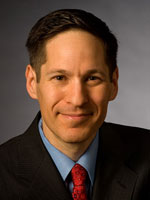Q and A with CDC Director Tom Frieden
July / August 2014 | Volume 13, Issue 4

CDC Director Dr. Tom Frieden
Dr. Tom Frieden became Director of the U.S. Centers for Disease Control and Prevention (CDC) in June 2009. A physician with training in internal medicine, infectious diseases, public health and epidemiology, he is especially known for expertise in tuberculosis control. As Commissioner of the New York City Health Department from 2002-2009, he directed the city's efforts to reduce smoking, cut transfats from restaurant menus and establish electronic health records. Frieden received both his medical degree and master’s in public health from Columbia University.
Why is the CDC engaged in global health?
Sometimes, people wonder, "Why should we be involved in global health since we have so many challenges here at home?” But we can't keep Americans safe just looking at our own country. We need to make sure that we're not only protecting ourselves from diseases that can spread from elsewhere, but also learning lessons that can be learned elsewhere, sometimes more efficiently and effectively.
We're also promoting stability around the world. We're increasing economic productivity around the world and lifting all boats by having healthier communities. We're promoting the reputation of America. I'll never forget the woman I met in Nigeria who was holding her twin babies in her hands and she said to me, "I'm HIV-positive, but my babies are HIV-negative because of PEPFAR [the President's Emergency Plan for AIDS Relief]. And thank the American people for me."
And ultimately, our work in global health is so important to do because it's the right thing to do, because we're a great country and because for a very small investment, we can make a massive change in the lives of literally billions of people.
What global threats concern you?
We face a real storm of vulnerability. There are new risks from new infections like H7N9 influenza. There are resistant organisms, and we're now seeing some microbes that are resistant to all our treatments. And, unfortunately, there is the possibility of the spread of intentionally created organisms either through a bioterrorist attack or through the inadvertent release of organisms. With our globalized world, a threat anywhere is a threat everywhere. If there is the emergence of a disease in any part of the world, it could be in any other part of the world within a day.
What can be done?
Pathogens cross borders effectively, and that's why we need to improve further on our support and partnership with the World Health Organization and with countries around the world to better find, stop and prevent threats to health. That will make for a safer United States and a safer world, because we really are interconnected.
In order to do more in terms of finding, stopping and preventing diseases, we need some core capacities to increase the ability of governments and society to recognize, respond and bounce back, to increase resilience. For detection, we need laboratory networks. For response, we need effective emergency operation centers that can scramble in real time and marshal people who can create a rapid response team and stop an outbreak. And for prevention, we need to be able to get high levels of vaccination and respond to outbreaks effectively to stop them and prevent other threats to health from emerging. Unfortunately, the vast majority of the world does not yet have these capacities fully developed, but fortunately there is a global commitment to do so.
How do partnerships make the world safer?
The ability of public health to find and stop outbreaks is in everyone's best interest. China's story of H7N9 collaboration is a great example of that. Ten years ago, when SARS emerged in China, they did not handle it well. It cost the world $30 billion to deal with SARS. And when H7N9 came about, we then had 10 years of collaboration with the Chinese public health authorities to build on; 10 years of trust, 10 years of capacity building. And from the first hours after they identified the organism, they have been absolutely transparent. They have posted that organism's genome onto the Internet. That allowed us to download it and make a diagnostic test, which we've sent out to every state, dozens of countries and used for any patient with suspected H7N9 influenza.
With that genome, we were able to begin to make a vaccine, to make seed strains, to identify challenges in making that vaccine and address those challenges. Now, what we hope will be an effective vaccine is entering clinical trials. That's the harvest of 10 years of collaboration, 10 years of working together that allowed us to help the Chinese know how to diagnose flu, know how to set up a monitoring network and know how to sequence the genome. That kind of collaboration protects all of us.
This feature was adapted from Dr. Frieden's press briefings on September 10, 2013, December 5, 2013 and February 12, 2014.
More Information
To view Adobe PDF files,
download current, free accessible plug-ins from Adobe's website.